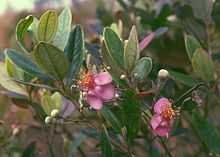Rhodomyrtus
From Wikipedia, the free encyclopedia
| Rhodomyrtus | |
|---|---|
 | |
| Rhodomyrtus tomentosa in Phnom Bokor National Park, Cambodia | |
| Scientific classification | |
| Kingdom: | Plantae |
| (unranked): | Angiosperms |
| (unranked): | Eudicots |
| (unranked): | Rosids |
| Order: | Myrtales |
| Family: | Myrtaceae |
| Genus: | Rhodomyrtus (DC.) Rchb. |
| Species | |
|
See text. | |
Rhodomyrtus is a genus of 24 species (one species undescribed) of shrubs and trees in the family Myrtaceae.[1] The genus is native to Asia, Malesia, Melanesia, and Australia. Its greatest levels of diversity are on New Guinea and in northeastern Australia. DNA sequence data and morphological data indicate that the genus is artificial (polyphyletic). Additional studies are needed before it can be split into two or more smaller monophyletic genera (Snow et al. 2008).
Species include:
- Rhodomyrtus canescens C .T. White & Francis
- Rhodomyrtus effusa Guymer
- Rhodomyrtus elegans (Blume) A.J. Scott
- Rhodomyrtus guymeriana N.Snow
- Rhodomyrtus kaweaensis N.Snow
- Rhodomyrtus lanata Guymer
- Rhodomyrtus locellata (Guill.) Burret
- Rhodomyrtus longisepala N. Snow & J. McFadden
- Rhodomyrtus macrocarpa Benth. - Finger Cherry
- Rhodomyrtus mengenensis N.Snow
- Rhodomyrtus misimana N.Snow
- Rhodomyrtus montana Guymer
- Rhodomyrtus novoguineensis Diels
- Rhodomyrtus obovata C.T. White
- Rhodomyrtus pervagata Guymer
- Rhodomyrtus pinnatinervis (G. Don) Benth.
- Rhodomyrtus psidioides (G.Don) Benth. - Native Guava
- Rhodomyrtus salomonensis (C.T. White) A.J. Scott
- Rhodomyrtus sericea Burret
- Rhodomyrtus surigaoensis Elmer
- Rhodomyrtus takeuchii N. Snow & J. Cantley
- Rhodomyrtus trineura (F.Muell.) Benth.
- Rhodomyrtus tomentosa (Aiton) Hassk.
References
- Snow, N., J. McFadden, J. P. Atwood. 2008. Three new species of Rhodomyrtus (DC.) Rchb. (Myrtaceae) from Papua New Guinea. Austrobaileya 7: 691-706.
- ↑ "Rhodomyrtus". Australian Plant Name Index (APNI), IBIS database. Centre for Plant Biodiversity Research, Australian Government, Canberra. Retrieved 2008-11-02.
This article is issued from Wikipedia. The text is available under the Creative Commons Attribution/Share Alike; additional terms may apply for the media files.